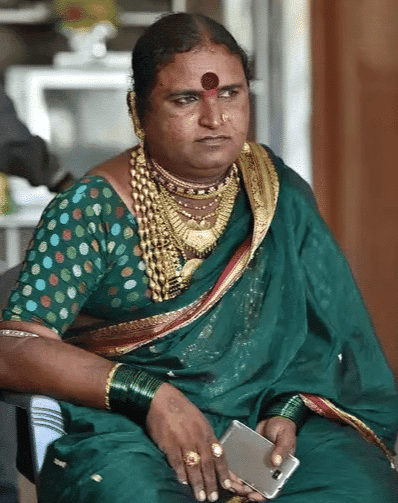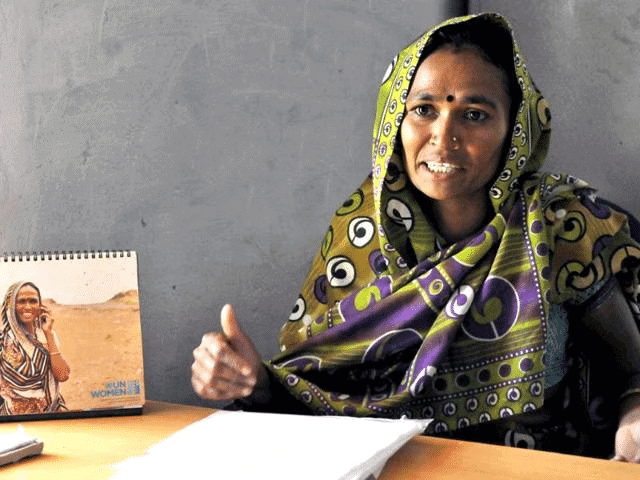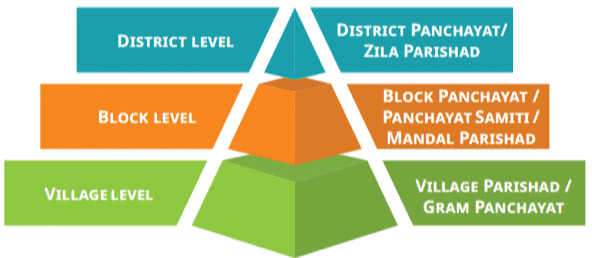Short & Long Question Answers: Grassroots Democracy — Part 2: Local Government in Rural Areas | Short & Long Answer Questions for Class 6 PDF Download
Short Question Answers
Q1: What does M.K. Gandhi mean by ‘The real India lives in its villages’?
Ans: M.K. Gandhi’s quote suggests India’s true essence thrives in its rural areas, home to nearly two-thirds of its 1.4 billion people across 600,000 villages. It highlights how village life—farming, community ties—defines India beyond cities.
- With Lakshmanpur’s 700 farmers as an example, it shows rural roots shape the nation’s identity, needing local governance like Panchayats to reflect this reality.
Q2: What is the Panchayati Raj system?
Ans: Panchayati Raj is a rural self-government system with councils called Panchayats. It operates at village, block, district levels, letting people decide on local needs—water, roads, schools. In Lakshmanpur, it helps 700 villagers manage daily issues, ensuring government schemes reach them. It’s a way for rural folks to govern themselves, bringing democracy close.
Q3: How does the Gram Panchayat function at the village level?
Ans: The Gram Panchayat, elected by the Gram Sabha—village voters—handles local matters like roads, schools, water. Its head, the Sarpanch, leads discussions where men, women decide together. A Secretary manages records, meetings; a Patwari tracks land. In Lakshmanpur, it tackles farming needs, showing how villagers directly shape their lives.
Q4: Who is Dnyaneshwar Kamble, what did they achieve as Sarpanch?
Ans: Dnyaneshwar Kamble, a transgender person, became Sarpanch of Tarangfal, Maharashtra, in 2017, beating six rivals. Guided by ‘lok seva, gram seva’—serving village, public—they brought change to their community. Their win shows anyone can lead, proving Panchayats open doors for diverse voices to improve rural life.
 Dnyaneshwar KambleQ5: How did Vandana Bahadur Maida transform her village?
Dnyaneshwar KambleQ5: How did Vandana Bahadur Maida transform her village?
Ans: Vandana Bahadur Maida, a Bhil woman, became Khankhandvi’s first female Sarpanch in Madhya Pradesh, breaking male norms. She urged women to join Sabha meetings, tackled education, sanitation issues, earning wide praise. Her leadership transformed her village, showing women’s power to uplift rural India through local governance.
 Vandana Bahadur Maida
Vandana Bahadur Maida
Q6: What changes did Popatrao Baguji Pawar bring to Hiware Bazar?
Ans: Popatrao Baguji Pawar, Sarpanch of Hiware Bazar, Maharashtra, turned a drought-hit village green, prosperous. Using Anna Hazare’s rainwater harvesting, watershed conservation, tree planting—lakhs strong—he boosted groundwater. Villagers’ teamwork made it thrive, earning him a 2020 Padma Shri, proving local effort can beat tough odds.
Q7: What role does the Patwari play in a Gram Panchayat?
Ans: The Patwari assists the Gram Panchayat by keeping village land records, often with maps centuries old. In Lakshmanpur, they’d track 200 households’ fields, helping settle disputes or plan farming. These old maps reveal past land use, aiding present decisions, making the Patwari key to rural order.
Q8: What is the Child-Friendly Panchayat Initiative?
Ans: The Child-Friendly Panchayat Initiative lets kids voice wellbeing concerns via Bal Sabhas, Bal Panchayats.
Example 1: In Maharashtra, it fights child labor, marriage, returning kids to school.
Example 2: Sikkim’s Sangkhu Radhu Khandu built school walls, kitchens for safe meals, showing Panchayats can prioritize children’s needs, rights.
Q9: How does the Children’s Parliament in Rajasthan work?
Ans: Rajasthan’s Children’s Parliament, from Bunker Roy’s Barefoot College, empowers kids aged 8–14 with education, democracy. Night schools, elections with voter IDs, campaigns pick a ‘Cabinet’ to manage schools, push community needs like sanitation. Winning a 2001 award, it grows leaders challenging norms.
Q10: What does the Panchayat Samiti do at the block level?
Ans: The Panchayat Samiti links Gram Panchayats to the Zila Parishad, coordinating block-wide plans. Elected locals, Sarpanchs, MLAs gather development ideas—like roads from schemes like Pradhan Mantri Gram Sadak Yojana—presenting them higher up. It ensures villages’ voices reach district, state for funds, action.
Q11: What is the Zila Parishad’s role in rural governance?
Ans: The Zila Parishad oversees district-level rural governance, uniting block plans. With elected members, Sarpanchs, MLAs, it manages agriculture, health, education across villages like Lakshmanpur. It secures funds, ensures schemes benefit all, amplifying local needs to state, strengthening the three-tier system.
Q12: How do Panchayati Raj institutions support disadvantaged groups?
Ans: Panchayati Raj reserves one-third of seats for women, includes rules for disadvantaged groups at all levels—village, block, district. This lets marginalized voices, like Vandana Maida’s, address needs—education, water—ensuring fair development. It lifts rural India by hearing everyone, not just the powerful.
Q13: What does Kautilya’s Arthashastra say about village governance?
Ans: Kautilya’s Arthashastra, 2,300 years old, outlines governance from villages up: sangrahana (10 villages), karvațika (100), dronamukha (400), sthānīya (800). It matches today’s Panchayati Raj tiers—village, block, district—showing ancient roots of local rule. Kautilya aimed for order, prosperity, mirroring modern rural systems.
Long Question Answers
Q1: What are Panchayati Raj institutions, how do their three tiers function?
Ans:
- Panchayati Raj institutions are rural self-government bodies—Panchayats—spanning village, block, district levels, a three-tier system.
- At the base, Gram Panchayats, elected by Gram Sabhas, handle village needs—roads, schools, water—for places like Lakshmanpur’s 700 farmers.
- Led by a Sarpanch, aided by a Secretary, Patwari, they decide locally.
- The Panchayat Samiti, at block level, connects villages to districts, coordinating plans—like all-weather roads via schemes—gathering Sarpanchs, MLAs, locals to pitch ideas upward.
- The Zila Parishad tops it, overseeing district-wide issues—agriculture, health, housing—ensuring funds, schemes reach all.
- Each tier builds on the last: villages start, blocks link, districts deliver.
- This setup covers rural life’s facets, letting 600,000 villages govern themselves, blending direct votes with higher coordination for growth, harmony.

Q2: What functions do Gram Panchayats serve, how do exemplary Sarpanchs show their impact?
Ans:
- Gram Panchayats manage village essentials—water, roads, schools, health—elected by Gram Sabhas to solve daily issues.
- In Lakshmanpur, they’d fix rain-damaged roads, irrigate fields, aided by Secretaries for records, Patwaris for land.
- Their impact shines through Sarpanchs like Dnyaneshwar Kamble, a transgender leader in Tarangfal, Maharashtra, serving with ‘lok seva, gram seva,’ proving diverse voices can win, lead.
- Vandana Bahadur Maida, a Bhil woman in Khankhandvi, Madhya Pradesh, broke norms, boosting women’s Sabha roles, education, sanitation—showing transformation starts local.
- Popatrao Pawar greened Hiware Bazar with rainwater harvesting, tree planting, earning a 2020 Padma Shri, turning drought to bounty.
- These leaders highlight Gram Panchayats as engines of change, directly lifting rural lives with grit, community effort.
Q3: Why are Panchayati Raj institutions vital for democracy, how do child-friendly efforts strengthen this?
Ans:
- Panchayati Raj institutions fuel democracy by letting rural people—two-thirds of 1.4 billion—govern themselves, per Gandhi’s village vision.
- Gram Sabhas vote, discuss, decide on local needs—water, roads—while Samitis, Zila Parishads scale plans up, ensuring grassroots voices hit state levels.
- Reserving seats for women, disadvantaged groups deepens this, giving all a say, like Vandana Maida’s rise.
- Child-friendly efforts amplify it: Bal Sabhas, Panchayats in Maharashtra stop child labor, marriage, push schooling; Sikkim’s Sangkhu Radhu Khandu builds safe schools, kitchens.
- Rajasthan’s Children’s Parliament elects kids to lead, tackle education, equality, winning a 2001 award.
- These initiatives grow young democrats, ensuring even kids shape their world, making Panchayats a living root of India’s vast, inclusive rule.
FAQs on Short & Long Question Answers: Grassroots Democracy — Part 2: Local Government in Rural Areas - Short & Long Answer Questions for Class 6
| 1. What is grassroots democracy in the context of local government in rural areas? |  |
| 2. How does local government function in rural areas? |  |
| 3. What role do elections play in grassroots democracy at the local level? |  |
| 4. What are the benefits of having local governments in rural areas? |  |
| 5. How can citizens participate in local government activities? |  |
















